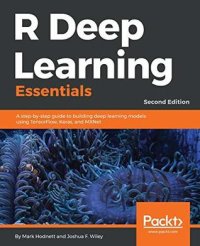
Ebook: R Deep Learning Essentials: A step-by-step guide to building deep learning models using TensorFlow, Keras, and MXNet
Author: Wiley Joshua F, Hodnett Mark
- Year: 2018
- Publisher: Packt Publishing - ebooks Account
- City: Birmingham
- Edition: 2nd edition
- Language: English
- epub
Deep learning is a branch of machine learning based on a set of algorithms that attempt to model high-level abstractions in data by using model architectures. With the superb memory management and the full integration with multi-node big data platforms, the H2O engine has become more and more popular among data scientists in the field of deep learning.
This book will introduce you to the deep learning package H2O with R and help you understand the concepts of deep learning. We will start by setting up important deep learning packages available in R and then move towards building models related to neural networks, prediction, and deep prediction, all of this with the help of real-life examples.
After installing the H2O package, you will learn about prediction algorithms. Moving ahead, concepts such as overfitting data, anomalous data, and deep prediction models are explained. Finally, the book will cover concepts relating to tuning and optimizing models.
What you will learn Set up the R package H2O to train deep learning models Understand the core concepts behind deep learning models Use Autoencoders to identify anomalous data or outliers Predict or classify data automatically using deep neural networks Build generalizable models using regularization to avoid overfitting the training data About the AuthorDr. Joshua F. Wileyis a lecturer at Monash University and a senior partner at Elkhart Group Limited, a statistical consultancy. He earned his PhD from the University of California, Los Angeles. His research focuses on using advanced quantitative methods to understand the complex interplays of psychological, social, and physiological processes in relation to psychological and physical health. In statistics and data science, Joshua focuses on biostatistics and is interested in reproducible research and graphical displays of data and statistical models. Through consulting at Elkhart Group Limited and his former work at the UCLA Statistical Consulting Group, Joshua has helped a wide array of clients, ranging from experienced researchers to biotechnology companies. He develops or codevelops a number of R packages including varian, a package to conduct Bayesian scale-location structural equation models, and MplusAutomation, a popular package that links R to the commercial Mplus software.
Table of Contents Getting Started with Deep Learning Training a Prediction Model Preventing Overfitting Identifying Anomalous Data Training Deep Prediction Models Tuning and Optimizing Models Bibliography